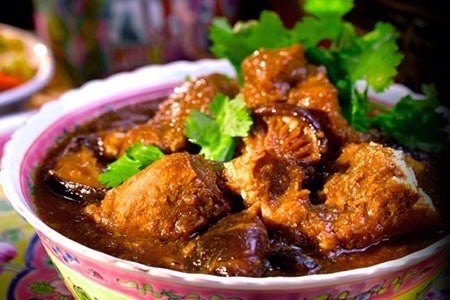Traditional Peranakan food or Nyonya cuisine combines Chinese, Malay and other influences into a unique blend. It is the result of blending Chinese ingredients and wok cooking techniques with spices used by the Malay/Indonesian community.
Nyonya food is tangy, aromatic, spicy and herbal. Key ingredients include coconut milk (santan), galangal (lengkuas) (a subtle, mustard-scented rhizome similar to ginger), candlenuts (buah keras) as both a flavoring and thickening agent, laksa leaf, pandan leaves (Pandanus amaryllifolius), belachan, tamarind (asam jawa) juice, lemongrass (serai), torch ginger bud (bunga kantan), jicama (sengkuang), fragrant kaffir lime leaf, rice or egg noodles and cincaluk - a powerfully flavored, sour and salty shrimp-based condiment that is typically mixed with lime juice, chillies and shallots and eaten with rice, fried fish and other side dishes.
There are regional variations in Nyonya cooking. Traditional Peranakan food from the island of Penang in the northern part of Peninsular Malaysia show Thai influences, such as more liberal use of tamarind and other sour ingredients. Peranakan dishes from Singapore and Malacca, on the other hand, show a greater Indonesian influence, such as the use of coconut milk. A classic example is laksa (a spicy noodle soup), which comes in two variants: the sour asam laksa from Penang and the coconut milk-based laksa lemak from Singapore and the southern regions of Peninsular Malaysia.




No comments:
Post a Comment